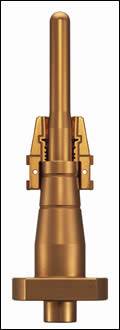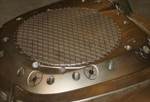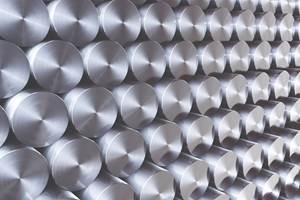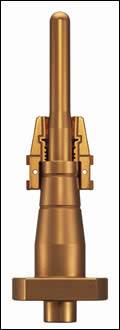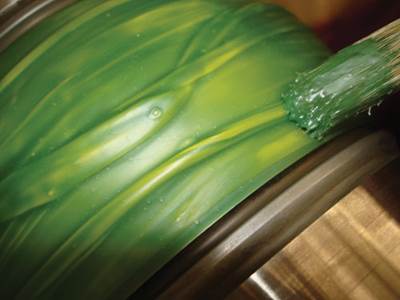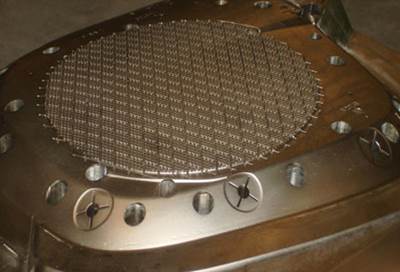
Beryllium copper core coated with engineered electroless nickel diamond. Photo Credit: Bales Metal Surface Solutions
Mold builders and molders should carefully consider coating selection if they want to extend the life of molds and components made of soft base material such as aluminum and beryllium copper (BeCu).
Aluminum is excellent for machining quick prototype cavities and cores to quickly deliver a mold to the customer. Beryllium copper offers the required strength and thermal conductivity to improve cycle time and finished part quality.
A common issue manufacturers experience when running soft base material components is the abrasive material quickly attacking the mold’s surfaces, especially at the gate, vent and end-of-fill. Other challenges are poor output from the start, longer cycle times, mold cleaning, components designed without draft and frequent engineering changes (design or material).
Selecting the appropriate engineered coating to better manage or overcome these challenges is essential. Look for suppliers who offer a user-friendly coating comparison tool that reviews six different engineered coatings per four key coating features: coefficient of friction, Rockwell hardness (HRC), operating temperature and a simple rating system for corrosion, abrasion and release.
Another coating selection aid to look for from a supplier is similar to a virtual doctor’s visit with a physician, except that it is a 15-minute appointment with an experienced coating professional. A simple mouse click pulls up a calendar to schedule a meeting date and time for a video or conference call.
Coating Call
A recent customer request involved a shop running an aluminum prototype mold. We examined the mold running and a finished piece part. We determined that the mold was built to run non-filled resin, causing wear and creating an out-of-spec part. We made an engineering change and switched the resin to a 40% glass-filled material. We suggested repairing the worn areas causing flash and then coating the mold with an engineered electroless nickel diamond coating, giving the soft base material a 57 HRC. A follow-up call revealed that the mold was running with no signs of wear and even released better from the core.
Mold coatings help shops turn a prototype mold into a production mold.
Typically, electroless nickel boron nitride or engineered electroless nickel diamond coatings are recommended for shops working with soft base materials. An electroless nickel boron nitride coating is considered a release coating with 54 HRC. An engineered electroless nickel diamond coating is regarded as the next level in the electroless nickel family with 57 HRC. The added hardness works well with materials with fiber or glass fillers. The thickness of both coatings runs from 0.0002 to 0.0003 inches per side, with the option to go as little as 0.00005 inches per side for tight-tolerance parts. This thickness will not affect the thermal conductivity of a beryllium copper component. Also, you can mask non-molding or fit areas in tight areas of a mold, then coat the entire component for value-added protection.
Mold coatings help shops turn a prototype mold into a production mold. Choosing a suitable coating for your soft base materials can provide additional hardness that protects molds and components from wear and abrasion, extremely low coefficient-of-friction numbers that ease part release and easier material flow into the cavity that improves cycle time.
Related Content
Mold Design Review: The Complete Checklist
Gerardo (Jerry) Miranda III, former global tooling manager for Oakley sunglasses, reshares his complete mold design checklist, an essential part of the product time and cost-to-market process.
Read MoreIt Starts With the Part: A Plastic Part Checklist Ensures Good Mold Design
All successful mold build projects start with examining the part to be molded to ensure it is moldable and will meet the customers' production objectives.
Read MoreMaking Quick and Easy Kaizen Work for Your Shop
Within each person is unlimited creative potential to improve shop operations.
Read MoreWhat You Should Consider When Purchasing Modified P20 Steel
When buying P20 steels that have been modified, moldmakers must be aware of the variations and key issues that affect delivery, cost and lead times.
Read MoreRead Next
Coatings Enhance Tool Life and Performance
Surface coatings have evolved over the past decade—offering improved operation uptime, greater consistency and higher part quality
Read MoreA Sticky Situation: What Surface Treatment Do I Really Need?
Over the years, and more times than can probably be counted, customers call from all over to order various surface treatments for their molds, without knowing what is truly needed to make their molds run better and more efficiently.
Read MoreIncrease Mold Protection, Decrease Cycle Times
How to achieve optimal cycle times with the right plating option and the role of early involvement between molder/OEM.
Read More

